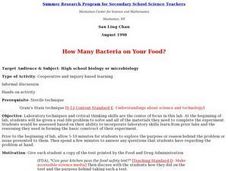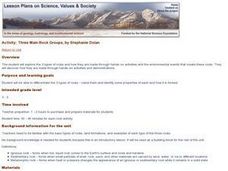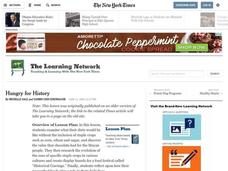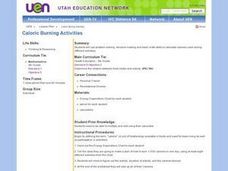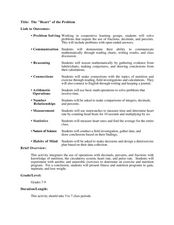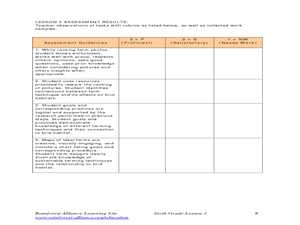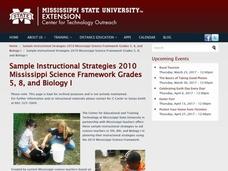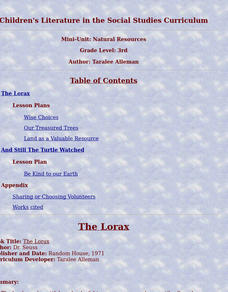Curated OER
Basic Nutrition (Nutri/Food)
Students analyze the nutrition found in a food and compare it to the nutrition found in similar food. They compare the nutrition of different products and complete the student worksheet Pyramid Pizzazz. This can be done at the beginning...
Curated OER
Foods ll Introductory Review
Ninth graders identify and explain the appropriate use and care of basic kitchen equipment. They assess their skill level to determine to what extent to cover the basics in kitchen equipment, microwave cooking, abbreviations,...
Curated OER
What Food Is It?
Students close their eyes and taste foods without using the sense of sight to identify the foods. They record what they think the food is that they tasted.
Curated OER
Giant Fast Food - McTwisted
Students discover the basics of Trademark Law understanding that companies are very protective of their trademarks and trade dress. Companies should be contacted for permission to derive their products. After obtaining permission,...
Curated OER
Health: Basic Minerals
Students examine minerals as food nutrients and discover their importance as food sources in the diet. Among the learning options are completing worksheets, creating recipes, making billboards, and actually preparing some recipes rich...
Curated OER
How Many Bacteria on Your Food?
High schoolers discuss and conduct a food safety experiment which looks at bacteria and food poisoning. They swab the other area of some food and grow bacteria in an agar plate.
Curated OER
Three Main Rock Groups
Students are introduced to igneous, sedimentary and metamorphic rocks. They use foods to demonstrate the basic formation of each type of rock, read books about rock formation and view related videos.
Curated OER
Southeast Asian Food and Culture
Pupils become familiar with some of the food of Southeast Asia. The explore various examples of how culture has been shaped through the influence of food within Southeast Asia.
Science Matters
Ecosystem Pre-Assessment
Test scholars' knowledge of ecosystems with a 20-question pre-assessment. Assessment challenges learners to answer multiple choice questions, read diagrams, and complete charts.
LABScI
Atomic Structure and the Periodic Table of Elements: The Secret Agent Lab
Food always gets attention! Model atomic structure using fruit loops to represent the subatomic particles. After building models, scholars create ionic bonds using their models. Finally, they use these concepts to create a periodic...
Curated OER
America, A Home for Every Culture
Students investigate the many cultures that are represented in America. In this American culture lesson, students look at the food, languages, music, and traditions that immigrants have contributed to the face of America. They complete...
Curated OER
Hungry for History
Students examine what their diets would be like without the inclusion of staple crops such as corn, wheat and sugar, and discover the value that chocolate had for the Mayan people. They create display boards for a food festival.
Curated OER
Caloric Burning Activities
Fourth graders use problem solving, decision making and basic math skills to calculate calories used during different activities. They determine the relation between food intake and activity. Students also figure out the activity,...
Curated OER
You Are What You Eat: Lessons from Alice Waters
Students view the AMERICAN MASTERS episode titled ALICE WATERS AND HER DELICIOUS REVOLUTION. They examine their own eating habits and determine how they can eat food that is both healthier and tastier. Through Guided Reading strategies,...
Curated OER
The "Heart" of the Problem
Students create an exercise and nutrition program. In this interdisciplinary lesson, students use calculations of exercises plus their corresponding effects on the body and nutritional values of food to derive a health plan. Students...
Curated OER
How can my breakfast help the birds?
Sixth graders design farms with a bird's habitat in mind. In this farm lesson plan, 6th graders research how sun grown coffee destroys a bird habitat, and then they make their own farm with a bird's habitat being preserved. They then...
Curated OER
Healthy Eating Patterns
After preparing baked potato nachos, the class views a PowerPoint about healthy food choices and takes notes on an accompanying worksheet. Although the PowerPoint is educational, the majority of the time is used for preparing and...
Curated OER
Real-World Projects: Challenges from the Polymer Industry
Two scenarios are presented for chemistry detectives to decipher. Both require the use of an infrared spectrometer and focus on the examination of polymer materials. In the first, lumps in polyethylene bottles are analyzed. In the...
Curated OER
Race To Win Project
Students develop proper work and personal skills that will enable them to become competent and confident adults. Students analyze basic nutritional habits. Students evaluate sport/athletic food patterns.
Curated OER
Nutrition Awareness
High schoolers gain an awareness of nutrition. In this science lesson plan, students explore how to determine his or her ideal body weight, demonstrate familiarity with the food groups relating to kilocaloric content, estimate the basic...
Curated OER
Menu Math
Learners follow the food pyramid to create a daily food budget. They research food prices online or in newspapers. They graph the amount of each food group included in their menus. They can also create a weekly food menu based on a fixed...
ARKive
Temperate Rainforest in the Pacific Northwest
Explore the amazing temperate rainforest of the Pacific Northwest. Your class starts by investigating the animals and plants of the Northwest, specifically Washington, and then research an animal population common to the area. In small...
Science 4 Inquiry
Eukaryotic Cells: The Factories of Life
Eukaryotes include humans, animals, and plants. Scholars learn about the parts of eukaryotic cells. They design models of a store and match the correct function of each part to the function of a part of the cell. They review their...
Curated OER
Land as a Valuable Resource
Students investigate why the soil is important to our lives. In this natural resources lesson, students have a farmer as a guest speaker. Students begin to understand how farmers use and protect our natural resource. Students write...
Other popular searches
- Five Basic Food Groups
- Four Basic Food Groups
- 4 Basic Food Groups
- 5 Basic Food Groups
- Basic Food Groups Free
- 3 Basic Food Groups
- Basic Food Groups Worksheets





